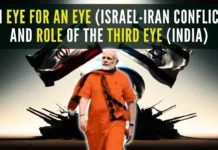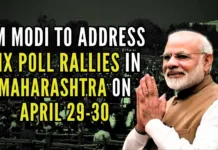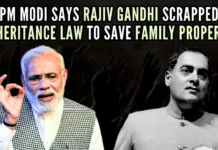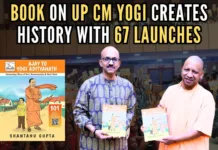
Why is education important in a democracy?
Free and fair elections are the mother of democracy and well-educated electorates are the roots for making the informed choice in electing the right leaders to uphold democracy. Thus, for the world’s largest and most thriving democratic Bharat, it is not a choice between educating youth and holding the elections for sustained democracy?
As Bharat undergoes Parliamentary elections with its first of seven phases this week, the race among the political parties is on with star campaigners and the candidates making whirlwind tours. For example, Chief Minister Yogi and Prime Minister Modi are out on the road to motivate people to vote for their ruling Bhartiya Janata Party (BJP). Others like Rahul Gandhi and his sister Priyanka are doing the same for the Congress party, once the largest in Bharat. This race to the top will keep the nation engaged with political rhetoric and claims to win. While there is no absolute certainty until the final vote count on June 4, all indicators point to Modi racing to the top as Prime Minister for the third term.
What is the status of Bharat’s race in educating the youth, the future electorate, at a considerably basic level? We focus on the proficiency in reading, writing, and numeracy of government school children, particularly in rural areas. Admittedly, the nation has come a long way since the Right to Education was enacted. However, Bharat has miles to go in reforming and improving education to realize the dream of a Developed Bharat by 2047.
The New Education Policy calls for many structural reforms at all levels. For example, combining Anganwadi with basic education i.e., 4 years of play school, KG, and grades 1 and 2 followed by 6 years of grades 3-8 as the foundational education. It is great on paper but not yet visibly implemented on the ground, at least in Uttar Pradesh which is most familiar to the author. The Anganwadi children are now part of the Midday meal but not under the wings of the Department of Basic Education to ensure adequate learning before getting to the first grade.
Our observations and analysis are based on the whirlwind visits of twenty-plus rural schools in Saharanpur district which incidentally holds elections in the first phase. Saharanpur district is just an example where the author was born but not alone in the race to the top. Recently, the author was in Bharat on behalf of a US-based NGO, Vidya Gyan, and its sister Vidya Gyan India. These NGOs have been aiding the rural government schools in Saharanpur for nearly 8 years.
Admittedly things have improved for the better. One recent Government of India scheme is NIPUN (National Initiative for Proficiency in Reading with Understanding and Numeracy). Under this initiative, the U.P. government mandated that all children in grades 1-3 gain proficiency in reading and numeracy. A well-intended initiative indeed but the schools were under intense pressure for testing children repeatedly and yet all schools are not deemed NIPUN.
Not too surprising, the NIPUN outcomes were a mixed bag. Many schools won the race to become “Saksham,” a coveted designation with 80% or more students deemed NIPUN, i.e., proficient in reading and numeracy. In fact, the author had the pleasure of being part of a recognition ceremony of nearly 70 Saksham schools in the Saharanpur district.
The question is about the schools that were deemed “Madhyam” (middle category with only 50-79% students attaining NIPUN competencies ) and the “Sangharshsheel” (struggling with less than 50% proficient students). We are afraid that NIPUN is a well-meaning effort but perhaps not too wise to have all eggs in one basket. The holistic development of children at the Anganwadi level for grade one readiness was neglected.
The author visited schools to meet the third graders who were part of a Vidya Gyan-sponsored initiative called “Super 20 (S-20).” It is aimed at offering slightly higher-level but holistic learning with a greater focus on leadership development. Less than a dozen schools were participating in S-20. While the author’s assessment of children’s content knowledge was not very scientific, it yielded mixed success similar to NIPUN. About one-half of the students were deemed “Saksham,” and the other half were not. We were not thrilled but not entirely disappointed.
While the outcomes of statewide NIPUN and S-20 could be better, it was interesting and inspirational that teachers self-assessed their S-20 efforts to be 90% or better. They also assessed student learning between 80-95%. The author interprets it to be a positive and encouraging sign of teachers’ commitment to improved learning. It was by no means a failed attempt because FAIL means the First Attempt In Learning in the words of late President Kalam.
Another significant outcome of our visits to new schools was their expression of interest in Vidya Gyan’s S-20. The visits were meant to assess the level of commitment to the S-20 objectives and team effort, infrastructure, support of the head teacher, and an invitation for an S-20 meeting on Sunday, March 31. Who would give up their Sunday unless s/he was seriously and voluntarily committed to improving students’ learning?
The response from the schools was overwhelming. About thirty teachers came for the meeting including those already a part of S-20 and others intending to join S-20. There is no better way but to characterize it as a successful ‘Super Sunday’ meeting. The graph shows the success of Super Sunday- the near doubling of the number of S- 20s in 2024 across twenty schools. Several schools will host more than one S-20.

Returning to the theme of elections, it appears certain that the race to the top slot is destined to bring back Modi as the Prime Minister in 2024. On the education front, the nationwide NIPUN and smaller-scale efforts like Super 20 clearly point to Bharat’s commitment to improved learning. The race towards improved and accelerated learning for the millions in government schools is critical to fulfilling Bharat’s dream of a “developed” country by 2047. It is equally important for Bharat’s electorate to be well-educated in upholding democracy.
Note:
1. Text in Blue points to additional data on the topic.
2. The views expressed here are those of the author and do not necessarily represent or reflect the views of PGurus.
For all the latest updates, download PGurus App.
- An Eye for an Eye (Israel-Iran conflict) and role of the Third Eye (India) - April 29, 2024
- Education and election in Bharat: Race to the top - April 16, 2024
- Kejriwal: “An Insignificant Man” or a corrupt politician with impending prison term - March 24, 2024










